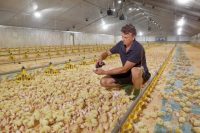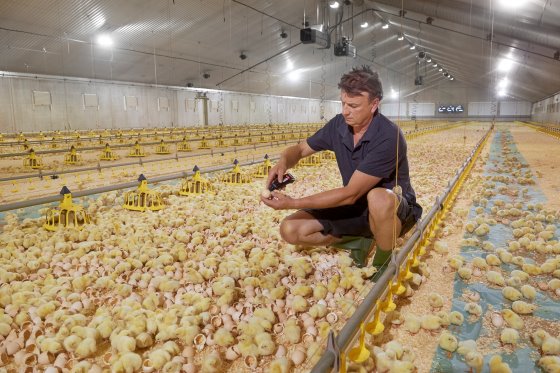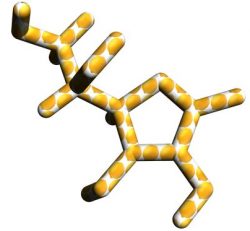HATCHING CHICKS INSIDE THE POULTRY HOUSE
At the beginning of this year, the Belgian-Dutch hatchery group BHV launched its concept to hatch chicks inside the poultry house: NestBorn. Dutch broiler farmer Robèr van Zutven has been involved with this concept from the beginning and is very enthusiastic.
The attention for hatching chicks inside the poultry house is increasing in north west Europe. One of the advantages is early feeding: chicks have direct access to feed and water. In addition to this, the stressful moments in the hatchery and during transport are avoided. Several Dutch and Belgian companies have developed concepts and systems to stimulate hatching inside the poultry house. One of these concepts is NestBorn, in which 18-day incubated eggs are placed on a thick litter bed inside the poultry house. NestBorn aims to bring hatching inside the poultry house within the reach of every poultry farm, without large investments or management adjustments.

Van Zutven keeps 140,000 chicks in three poultry houses. He sees a bright future for hatching inside the poultry house.
Photos: Van Assendelft Fotografie
The concept
Within the NestBorn concept, a special machine places the 18-day incubated eggs on a 5 to 6 cm thick and 2 m wide litter bed inside the poultry house. Several eggs are then connected to the so-called Ovoscans (developed by producer Petersime). The Ovoscans measure the temperature inside the eggshell and in the air as well as the relative humidity in real-time. The obtained data are accessible to both the poultry farmer and the hatchery through a mobile web application. By controlling the air temperature, the hatching eggs remain within the ideal limits during the hatching period. These data assist the hatcheries in supervising the hatching process.
International launch
The Belgian hatcheries Belgabroed and Vervaeke-Belavi and the Dutch chicken hatchery Van Hulst (both part of hatchery group BHV) were involved with the concept from the beginning. They were the first to supply the concept. By now, NestBorn has developed into a separate company that also wants to conclude license agreements with other parties, in order to advance the concept’s roll-out. It launched internationally at the VIV Europe this summer. In doing so, NestBorn wants to present itself outside the Netherlands, Belgium and Germany. It wants to show that the concept is also available for foreign hatcheries and integrations. By now, 50 to 60 broiler farms in the Netherlands and Belgium participate.

Within the NestBorn-concept, a special machine places the 18-day incubated eggs on a 5 to 6 cm thick and 2 m wide litter bed inside the poultry house. Several eggs are then connected to the so-called Ovoscans. Photo: Van Assendelft Fotografie
Practical experience
One of the participants is Dutch broiler farmer Robèr van Zutven. Two years ago, he grappled with Enterococcus problems that kept coming back flock after flock. Now that he has two years of NestBorn experience, 13 to 14 flocks later, he is very enthusiastic. “I have not experienced any problems with Enterococcus in the past two years. There will probably always be a flock that does not run smoothly, but if the problem occurs, it is very small indeed.”
He remembers the first round very well. “At first I thought, those chicks are ill. They stayed put when I walked past. It turned out they had no stress at all, not from the transport or the hatchery or from the difference in temperature when they come in. Furthermore, the effect of a banger is very small inside a poultry house, compared to a closed incubator.”
Hatching results
Van Zutven keeps 140,000 chicks in three poultry houses. He sees a bright future for hatching inside the poultry house. More than that, he expects that it may become a requirement in the Netherlands in the future. He only sees one disadvantage: “It takes three days more per flock. We are in a seven week cycle, so the leeway becomes minimal.”
The results of hatching inside the poultry house are hardly different from those in the hatchery: between 97% and 98%. “Even in an incubator in the hatchery, there are small differences in temperature,” according to Erik Hoeven from Belgabroed. Before the first set-up, the hatcheries perform a scan inside the poultry house. This serves to find out which heating and ventilation are used and where the beds should be positioned. A special machine places the eggs on the litter bed (50,000 per hour). The eggs sink in the litter beds for about one third. Hoeven adds, “We can separate the eggs more for a better air circulation, depending on the hens.”
Importance of the first week
On the first day, Van Zutven picks up and counts the eggs that did not hatch. He also does a first day selection that is normally performed in the hatchery. Not the nicest work, he admits, but the chicks’ increased health makes it more than worth his while. All this means that the first week is more labour-intensive, but that is compensated by smoother progress in the rest of the round. “I don’t know whether this is suitable for all farmers”, Van Zutven says. In the first week, he estimates that he works 24 hours more than with the traditional chicks. “Normally, when you deliver the chicks and clean the poultry house, you think: peace and quiet. Not in this case.” However, as far as he is concerned, attention in the first week is also essential for the regular chicks. At night, Van Zutven gets up every three hours in those first days. “The first week forms the basis, which must be good. They only have six weeks. A mistake is nearly impossible to repair.”

Before the first set-up, the hatcheries perform a scan inside the poultry house. This serves to find out which heating and ventilation are used and where the beds should be positioned. Photo: Van Assendelft Fotografie
Health advantages
It is remarkable that Van Zutven still starts with regular chicks in each round in one poultry house. Whereas the chicks hatched in the poultry house never needed antibiotics in the past two years, the regular chicks in the last round did need them. Why doesn’t he use NestBorn in all his poultry houses? “I don’t know actually. Working with two hatcheries keeps them sharp,” Van Zutven states. “And I have a good, trusted relationship with both. I think they will eventually all go into the poultry house after they are hatched.” Van Zutven does not see much difference where the slaughter weight is concerned. Feed conversion differs a few points in favour of the chicks hatched in the poultry house. “The biggest advantage is the health of the chick and the reduction of stress.”
By Kirsten Graumans
Source: www.poultryworld.net












